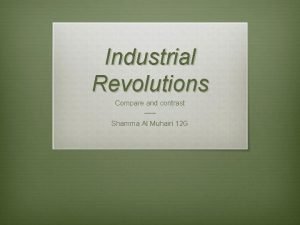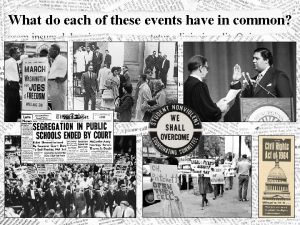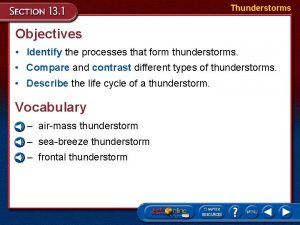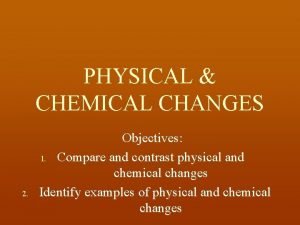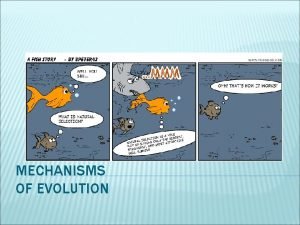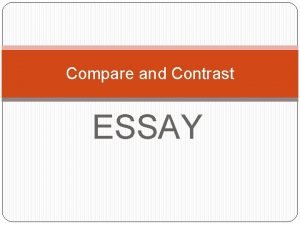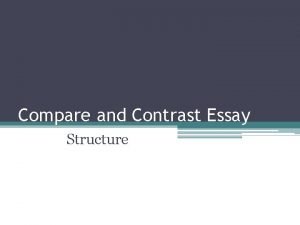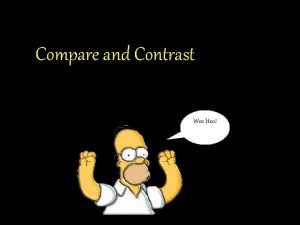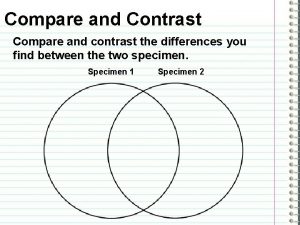Industrial Revolutions Compare and contrast Shamma Al Muhairi












- Slides: 12

Industrial Revolutions Compare and contrast ___ Shamma Al Muhairi 12 G

The Key Difference v The key difference between first and second industrial revolution is that the first industrial revolution was centered on Textiles, steam power, and iron while the second was centered on steel, railroads, petroleum, chemicals and electricity. First and second industrial revolutions can be considered as the turning points in the development of human history. The industrial revolution is said to have begun around the 1760 s and, depending on the development of technology, the industrial revolution can be categorized into the above mentioned two phases; first and second industrial revolution. This development is characterized by the transition of hand manufacturing to machine-based production. Many power tools were discovered and used for the benefit of economy of individuals as well as of the society. Let us first look at the two major phases of the industrial revolution in detail, and from there move on to identify the differences between first and second industrial revolution.

What Is First Industrial Revolution? With the industrial revolution, the living standard of people began to improve, and there was an economic development all around. First industrial revolution originated in Great Britain, and it spread to Western Europe and North America within a short period of time. As mentioned above, this transition ranges somewhere around 1716 s to 1820 s. In the first industrial revolution, there was a shift from the manual production process to machine manufacturing, introduction of chemicals, iron productions, development of water power and steam power, etc. Coal was used as a primary power generating source. However, almost all aspects of the life of people changed as a result of the industrial revolution. The income increased as a result of the increase of efficiency and this in turn increased the standard of living of many people. The textile industry was the first and fastest to use the modern technology and the cotton spinning powered by water or steam increased the output of the workers.

What Is Second Industrial Revolution? Second industrial revolution, which began somewhere in the 19 th century, is also known as the technological revolution. It is said to have begun in the 1840 s and spread until the First World War. The second industrial revolution is a continuation of the first industrial revolution and this was characterized with the increasing of adoption of the steam transport, large-scale manufacture of machine tools, and the increase in the use of steam-powered machines in the companies. Many railroads were built and a large-scale steel and iron productions could be seen. Another main invention of the second phase of the industrial revolution is electricity and electrical communication. The rapid industrial development in this period could be seen in Germany and United States. Apart from these, petroleum, paper making machines, automobiles, maritime technology, use of chemicals, etc. were also developed in a greater extent.

When & Where v The first, or old, Industrial Revolution took place between about 1750 and 1870 v Took place in England, the United States, Belgium, and France v Origin of First Industrial Revolution: The first industrial revolution started in Great Britain. v The second Industrial Revolution took place between about 1870 and 1960 v Saw the spread of the Industrial Revolution to places such as Germany, Japan, and Russia v Origin of Second Industrial Revolution : The second industrial revolution originated in Germany.

The First And Second Industrial Revolutions First Industrial Second Industrial Revolution v Machines were invented which replaced human labor Revolution v Electricity became the primary source of power for factories, farms, and homes v New energy sources were developed to power v Mass production, particularly of consumer the new machinery – goods water, steam, electricity, oil (gas, kerosene) v Increased use of metals and minerals. Aluminum, coal, copper, iron, etc. v Use of electrical power saw electronics enter the marketplace (electric lights, radios, fans, television sets)

Inventions Of The First Industrial Revolution Spinning Jenny v James Hargreaves developed the spinning jenny in 1764. This machine allowed workers to spin more wool at one time greatly increasing productivity. This invention was necessary for the industrialization of the textile industry. Steam Engine v Cotton Gin Power Loom v Edmund Cartwright invented the power loom in 1785. It dramatically changed the way cloth was woven by making it much easier. It would take almost another fifty years and several alterations by other inventors before it would become commonly used. James Watt created the first truly reliable steam engine in 1775. Other, less efficient models had been developed in the 1600 s. Watt’s version included a crankshaft and gears and is the foundation for modern steam engines. This invention made locomotives and many of the textile machines possible. v Eli Whitney patented the cotton gin (short for cotton engine) in 1794. Prior to the invention of the cotton gin, cotton seeds had to be removed from the cotton fiber by hand. This invention made cotton a much more profitable crop for farmers. With this invention, many more farmers turned to cotton as their main crop, greatly increasing the amount of cotton plantations in the South. These expanding farms needed cheap labor, which also resulted in an increased use of African slaves.

Inventions Of The Second Industrial Revolution Bessemer Converter Telegraph v A process, created by v A way to communicate Henry Bessemer, which produced steel faster by using extreme heat. Electric Light using wires, created by Samuel Morse. v A device which produces light using electricity, created by Thomas Edison. Transcontinental Railroad v The railroad which stretched across the entire United States, formed by a merge of the Central Pacific and Union Pacific Railroads.

Period of First and Second Industrial Revolution v First Industrial Revolution: The first industrial revolution was from 1760 to 1840. v Second Industrial Revolution: The second industrial revolution started in 1840 and went on until the First World War.

Characteristics of First and Second Industrial Revolution Name v First Industrial Fields of Transition v First Industrial Revolution: The first industrial revolution was centered on Textiles, steam power, and iron. v Second Industrial Revolution: The second industrial revolution or the technological revolution was centered on steel, railroads, petroleum, chemicals, and electricity. Revolution: The first industrial revolution was called “The Industrial Revolution”. v Second Industrial Revolution: The second industrial revolution was called as “Technological Revolution”.

The Results Of The Industrial Revolution Economic Changes • Expansion of world trade • Factory system • Mass production of goods • Industrial capitalism • Increased standard of living • Unemployment Political Changes • Decline of landed aristocracy • Growth and expansion of democracy • Increased government involvement in society • Increased power of industrialized nations • Nationalism and imperialism stimulated • Rise to power of businesspeople Social Changes • Development and growth of cities • Improved status and earning power of women • Increase in leisure time • Population increases • Problems – economic insecurity, increased deadliness of war, urban slums, etc. • Science and research stimulated

Similarities v The similarity between the two Industrial Revolutions is that they both involved an increase in the degree to which machines were being used to do tasks that had once been done in other ways. Yes, there were differences in that the earlier Industrial Revolution was more about things capital goods like steam engines while the second was about consumer goods. But, in both cases, the main thing that was going on was an increase in the use of machinery. This is what they have in common and what makes it legitimate to call both of these "Industrial Revolutions. ”.
 Shamma al muhairi
Shamma al muhairi Comparison chart romeo and juliet vs. west side story
Comparison chart romeo and juliet vs. west side story What was the purpose of the sibley commission
What was the purpose of the sibley commission Compare and contrast transverse and longitudinal waves
Compare and contrast transverse and longitudinal waves Compare and contrast spring tides and neap tides.
Compare and contrast spring tides and neap tides. Compare and contrast cold wave and wind chill factor
Compare and contrast cold wave and wind chill factor Expository text vs narrative text
Expository text vs narrative text Compare and contrast weather
Compare and contrast weather Contrast signal words
Contrast signal words The most dangerous game venn diagram
The most dangerous game venn diagram Compare and contrast transverse and longitudinal waves
Compare and contrast transverse and longitudinal waves Compare and contrast physical and chemical changes
Compare and contrast physical and chemical changes Compare and contrast gradualism and punctuated equilibrium
Compare and contrast gradualism and punctuated equilibrium
